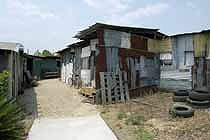
|
14th Vienna Architecture Congress Bottom up. Building For A Better World Location: Architekturzentrum Wien - Podium Congress: 17 November 2006 - 19 November 2006 Tickets: 1-day ticket: EUR 9.50 / EUR 6.50 reduced, 3-day-ticket: EUR 23.00 / EUR 16.00 reduced The 14th Vienna Architecture Congress places sustainable planning and building in its social, economic environmental and political context as a basis for discussion. The projects presented and the practices fall into two basic groups: university education-related where, in addition to the abstract academic curriculum, students are confronted with practical problems involved in the realisation of projects; and architectural initiatives, networks and offices concerned with participatory, sustainable and democratic planning and building processes for social situations in a context of development aid or catastrophe support. Where no official support is available for the building of infrastructure, local and international initiatives and educational programmes are formed that aim to close this gap and draw on the local population to spontaneously erect necessary individual buildings. Individual architects’ offices deliberately employ a two-track approach, developing new concepts for social housing developments alongside their prize-winning individual buildings – such as Alejandro Aravena in Chile. The way he improved the structures in a crisis-ridden city with the help of 'urban acupuncture' is described by Jaime Lerner, the mayor of and town planner in Curitiba, Brazil. 'S2arch. Social and Sustainable Architecture' is an Austrian educational programme whose buildings are on show in an exhibition running parallel to the symposium, and does not regard itself as a development aid project. Instead, they place an explicit focus on the participatory and practice-orientated aspects of educational work under the motto ’Learn together, build together’, a motto which 5 universities and a technical college followed, and built infrastructure and school buildings in townships in South Africa. The buildings of the individual student workgroups are presented in brief lectures and subsequently discussed in various rounds of talks. What happens in the cultural transfer of design concepts by European architecture schools in the context of a practical building programme? Can hegemonic relationships as discussed under the heading ’Postcolonial Studies’ be excluded from the architecture debate, and what are the key instruments and categories in teaching students the significance of social and sustainable architecture? |
 |
|
© Dorit Margreiter |
|
14th Vienna Architecture Congress Friday, 17.11.2006 Saturday, 18.11.2006 Sunday, 19.11.2006 Short Biographies Press Release: Focus At The Architekturzentrum Wien Gallery: Impressions from the 14th Vienna Architecture Congress Links: Architecture for Humanity Architects Without Borders Barefoot Architects Design Corps Habitat for Humanity Rural Studio S2Arch Education Africa – Modimo O Moholo Information: Lisa Kusebauch-Kaiser Tel.: +43 (1) 522 31 15 Fax: +43 (1) 522 31 17 Email: office@azw.at |
| © Architekturzentrum Wien 2025 |
||



